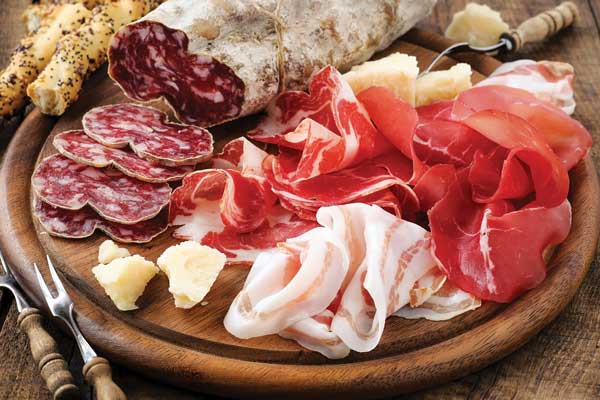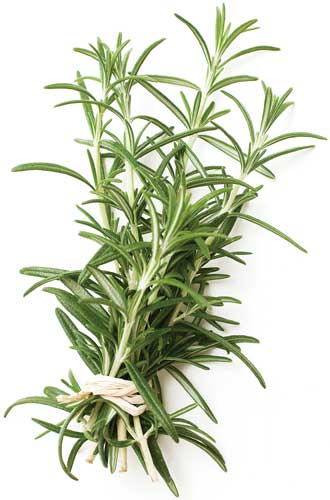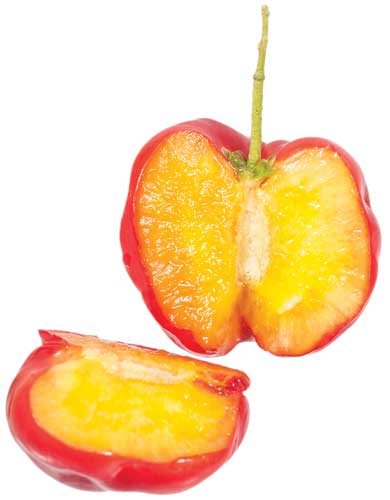Clean Label Approaches to Food Safety
INGREDIENTS
 Ensuring that food is safe and remains fresh or stable throughout its targeted shelf life is an ongoing challenge in the food industry. There are myriad ingredients that battle bad bacteria that grow on meat products, prevent mold growth on bread, or reduce the risk of off-flavors developing in cheese. Though these ingredients are deemed safe and effective by regulatory agencies, some do not meet the so-called clean label demands that a segment of consumers have placed on food manufacturers.
Ensuring that food is safe and remains fresh or stable throughout its targeted shelf life is an ongoing challenge in the food industry. There are myriad ingredients that battle bad bacteria that grow on meat products, prevent mold growth on bread, or reduce the risk of off-flavors developing in cheese. Though these ingredients are deemed safe and effective by regulatory agencies, some do not meet the so-called clean label demands that a segment of consumers have placed on food manufacturers.
“A key consumer trend in the food industry continues to be clean and clear label,” says Gary Augustine, executive director of market development at Kalsec. And specifically, 2017 Kalsec research shows that consumers’ top clean label concern is the removal of artificial ingredients, says Augustine. He adds that this includes preservatives such as TBHQ, BHA, BHT, and EDTA.
Kemin Food Technologies, another producer of food safety/preservation ingredients, is also addressing this trend with new additions like rosemary- and vinegar-based ingredients to its portfolio. “There is a definite shift happening towards clean label and ‘free from’ food and beverage,” says Courtney Schwartz, senior marketing communications manager at Kemin. “This can encourage food manufacturers to remove certain shelf-life ingredients or leave manufacturers searching for effective replacements. Reformulation of any matrix can greatly impact the safety and quality of the food by changing things such as pH, water activity, salt/sodium content—leaving your brand at risk. It is important that all ingredients are properly tested to ensure efficacy in the final matrix.”
With this clean and clear label movement comes an increased demand for ingredients that are domestically sourced, organic, or not genetically modified. “As consumers become more aware of the processing and manufacturing of their foods, more scrutiny will be placed, and the demand for increased transparency will grow,” remarks Schwartz.
Ingredient manufacturers are expanding their repertoire of food safety and preservation solutions to move beyond synthetic ingredients and explore clean label options—everything from herbs and spices to specially designed cultures.
Naturally Derived Antimicrobials
The emphasis on clean label, clear label, fresh, less processed, and the like means that food manufacturers and grocery stores are offering more foods and beverages that meet these qualities and satisfy the needs of many consumers. But the demand for these types of foods has had implications for food safety. “Rising consumer demand for food that is natural, minimally processed, fresher, and healthier means that microbial meat spoilage has reemerged as an issue on the food industry’s innovation agenda,” explains Catherine Bayard, food preservation category manager at Naturex. “This is principally because the traditional approaches to preventing pathogenic bacteria from outgrowth, such as stringent processing conditions and the use of artificial preservatives, are no longer compatible with the clean label trend. Chemical antimicrobial agents remain the predominant form of preservation but consumers view these with suspicion and are increasingly seeking out healthier products with labels that are cleaner, clearer, and easier to understand.”
Oxidation and bacterial contamination cause meat spoilage. Oxidation causes changes in the color and flavor of the meat product, and while it does not present a health risk to consumers, it can affect their perception of the quality of the product and their enjoyment of it, says Bayard. Microbial contamination, on the other hand, does pose a serious health threat to consumers, and Bayard calls it “one of the chief safety concerns in the meat industry.”
“Among the major bacterial risks in meat products, the pathogens Listeria and Salmonella top the list,” she continues. “While contamination is quite rare, the consequences for those affected can be devastating.”
 Synthetic antimicrobials are effective and widely used to keep meat products safe, but the drive to more naturally derived ingredients has shifted the emphasis to plant-based ones, which have been used for quite some time. “Over the centuries, distinct natural preservation techniques have been developed, including those based on spices and essential oils, many of which prevented spoilage but also affected the taste of the product,” says Bayard. To solve the issues with taste, Naturex conducted an antimicrobial research program that involved analyzing more than 200 extracts from different parts of edible plants to determine their antimicrobial activity against several different microbial species, explains Bayard. The results showed that an extract from rosemary was one of the most effective, exhibiting efficacy over a broad spectrum of microorganisms, including Gram-positive and Gram-negative ones, and yeasts, she says. “Naturex’s teams of experts in plant science and applications have access to hundreds of plant extracts thanks to a strong purchasing network. The performance of these plants against microorganisms were evaluated and the best candidates were chosen to characterize the effective active compounds. The process also determined the best plant associations, according to their mode of action on bacteria cells.” Bayard adds that the research led to the development of two naturally derived and taste-free antimicrobial ingredients for the prevention of spoilage in meat products.
Synthetic antimicrobials are effective and widely used to keep meat products safe, but the drive to more naturally derived ingredients has shifted the emphasis to plant-based ones, which have been used for quite some time. “Over the centuries, distinct natural preservation techniques have been developed, including those based on spices and essential oils, many of which prevented spoilage but also affected the taste of the product,” says Bayard. To solve the issues with taste, Naturex conducted an antimicrobial research program that involved analyzing more than 200 extracts from different parts of edible plants to determine their antimicrobial activity against several different microbial species, explains Bayard. The results showed that an extract from rosemary was one of the most effective, exhibiting efficacy over a broad spectrum of microorganisms, including Gram-positive and Gram-negative ones, and yeasts, she says. “Naturex’s teams of experts in plant science and applications have access to hundreds of plant extracts thanks to a strong purchasing network. The performance of these plants against microorganisms were evaluated and the best candidates were chosen to characterize the effective active compounds. The process also determined the best plant associations, according to their mode of action on bacteria cells.” Bayard adds that the research led to the development of two naturally derived and taste-free antimicrobial ingredients for the prevention of spoilage in meat products.
The two new ingredients,Cleanatis M1 and Cleanatis M2, are synergistic blends of plant extracts that prevent the growth of Listeria and Salmonella in the meat matrix without affecting the organoleptic properties of the end product, says Bayard. Cleanatis M1, a combination of two plant extracts (rosemary and citrus), helps inhibit Listeria (greater than 1.5 log at day 9 in ground beef challenge tests, according to Bayard). The other antimicrobial, Cleanatis M2, is a blend of rosemary, acerola, and buffered vinegar. Tests showed that the ingredient reduced Salmonella growth (2 log) in fresh ground meat samples and did not affect the color or flavor of the meat. “Both test results demonstrate that with Cleanatis M1 and M2, Naturex has succeeded in reconciling naturalness, transparency, and effective shelf-life management to create natural antimicrobials for meat products that do not impair flavor or appearance and enable clean labeling,” Bayard summarizes.
--- PAGE BREAK ---
 Clean Label Demands Drive Development
Clean Label Demands Drive Development
Some of the go-to shelf-life extension and food safety ingredients that meet clean and clear label demands are naturally derived, which is attractive to manufacturers working to remove synthetic preservatives from formulations. Sometimes, though, the naturally derived ingredients can introduce their own unique challenges to a formulation, as Schwartz explains about the use of buffered vinegar in protein applications such as meat and poultry. “Recently, there has been a shift within proteins to remove synthetic antimicrobials such as sodium lactate/diacetate. Buffered vinegar is an efficacious, consumer-friendly alternative but can contribute an undesirable amount of sodium to the final matrix. In response, Kemin launched BactoCEASE NV-K, a no-sodium buffered vinegar, which contributes zero sodium to the matrix, allowing manufacturers to meet clean label requests and provide a more healthful product.” The ingredient, which delays the growth of spoilage bacteria, is available in both liquid and dry forms for use in brines, marinades, and spice blends or for direct application to meat products. The liquid version also comes in a certified organic form.
Schwartz adds that it’s been tricky to develop a clean label ingredient like this because it’s more than just finding an efficacious solution. “It is equally if not more challenging to identify a solution that will not impact the sensory attributes of the matrix in which it is used. Consumers are very brand loyal, and even the slightest change in color, flavor, or smell could deter their loyalty.”
Kemin is also drawing on the plant world for sources of antioxidants. Rosemary is the source for a couple of its antioxidant ingredients. FORTIUM R is a line of rosemary extract–based antioxidants that protect against color and flavor degradation and function as replacements for BHA, BHT, or TBHQ. Rosemary extracts are combined with green tea extracts to produce FORTIUM RGT. The extracts work together to provide antioxidant protection without affecting flavor, color, and odor profiles of sauces, dressings, condiments, meat, and poultry.
Instead of being derived from rosemary, FORTIUM A is made from acerola extract, which is high in ascorbic acid, a compound that helps protect the color of food products. In meat products, acerola extract delays the oxidation of the iron ion in the myoglobin molecule, which in turn keeps the color of the meat more stable for a longer time, according to the company. Combining acerola extract with rosemary and green tea extracts extends the flavor and color even longer. These various FORTIUM antioxidant ingredients Kemin offers protect the quality of many types of food products. In meat and poultry, for example, they’ll help delay or prevent lipid oxidation (a contributor to off-flavors and off-aromas) and delay myoglobin oxidation (a contributor to color degradation).
 Plant-Based Solutions
Plant-Based Solutions
Naturally sourced ingredients are a big part of Kalsec’s ingredient lineup. “Kalsec’s portfolio has always included naturally sourced ingredients, but we have increased our development efforts to expand the inclusion and evaluation of other naturally sourced ingredients beyond rosemary such as green tea, acerola, and vinegar,” says Augustine. The company has expanded its application development to include areas in which the use of artificial preservatives is more prevalent, such as meat and poultry, oils, and dressings, he adds. The emphasis on clean label has led to different types of studies on the effectiveness of some of the company’s spice and herb extracts. “Kalsec also conducted a thermal inactivation study and Salmonella challenge studies with several spices and herbs through the Kalsec extraction process to confirm a greater than 5-log reduction in the finished extracts. A 5-log reduction is an industry target for pathogenic Salmonella in a validated kill step that no longer represents a concern for human illness. This confirmed that Kalsec liquid extracts safely reduce the risks for pathogens in food and beverage products.”
Simply put, Kalsec is leveraging the antioxidant benefits of compounds found in selected spices and herbs. “Natural antioxidants are present in rosemary to protect the plant against oxidative stresses associated with plant growth,” says David Johnson, lead scientist at Kalsec. “The Kalsec extraction process concentrates these natural antioxidants so they can be used in food systems to scavenge free radicals. By decreasing reactive free radicals in foods, these antioxidants extend the shelf life of foods naturally.”
Kalsec’s expertise in deriving food preservation ingredients from plant-based sources results in a range of clean label ingredient options to keep food fresh. “Kalsec Herbalox extracts provide shelf-life preservation with the advantage of a cleaner label than artificial preservatives,” says Augustine. “Herbalox XT rosemary extract provides shelf-life preservation but without all of the objectionable flavors associated with typical naturally sourced ingredients.” Many of the Herbalox ingredients are available in either liquid or dry forms and are standardized based on flavor, solubility (oil versus water solubility), and antioxidant efficacy, he adds. Another option is found in the Duralox Oxidation Management Systems, which combines Herbalox rosemary extract, green tea extract, acerola extract, and/or other ingredients to prevent oxidation in dressings, meat and poultry, oils, sauces, seasonings, and snack foods.
 Quality Throughout Shelf Life
Quality Throughout Shelf Life
The demands for clean label certainly affect ingredient and product formulating, but there are several others that shape new ingredient developments in the areas of food safety and food preservation. Customers of DuPont Nutrition & Health want more than just ingredient statements that meet the demand for clean and clear labels. They are also requesting guidance on regulatory issues related to the use of food protection ingredients and validation on effectiveness of the ingredient or process being used for food protection and the associated safety concerns with pathogens, says John Wyatt, regional product manager, food protection. They also seek ways to maintain the quality of the finished product throughout the desired shelf life and overcome abusive handling during distribution and by the end consumer. Finally, he adds that the ingredients must be effective, acceptable for flavor contribution, and have an acceptable cost-in-use.
DuPont Nutrition & Health develops, produces, and supplies an extensive portfolio of ingredients for food safety and food preservation that meet these demands and various food manufacturing requirements. It also focuses on providing effective food protection ingredients that are safe and that meet the requirements of clean and clear label ingredients, adds Wyatt.
Four distinct types of ingredients with properties that provide protection to and extend the shelf life of foods and beverages make up the DuPont Nutrition & Health’s food protection ingredient range. Naturally sourced antioxidants such as mixed tocopherols come in liquid and powered forms for ease of use and application in food processing, while flavor extracts such as rosemary, chamomile, green tea, and acerola provide appropriate flavors for many food products and have naturally occurring antioxidant and antimicrobial properties, says Wyatt. There’s also whole fraction fermentates that are products of biofermentation. “These are well-accepted clean label ingredients that provide an effective wide range of antimicrobial protection, and typically will enhance or contribute a favorable flavor to the finished product,” says Wyatt. “The blending of different fermentates provides products with a wider range for food protection, and there are unique synergies resulting from making these blends.” The last type of ingredient is also a result of biofermentation. Purified antimicrobials like nisin preparation and natamycin, Wyatt explains, are very concentrated and effective antimicrobials that do not contribute flavor due to the fact they are used in small dosages (a small dosage level is all that is required for them to be effective).
As the development of these types of ingredients and others that are even more effective at protecting food (and meet clean label demands) continues, Wyatt adds that there is still work to be done, especially as consumers and government agencies continue to demand and expect a safe food supply. “There is a constant demand for foods to have high quality at the end of an appropriate shelf life. Refrigerated foods are preferred over retorted, dried, or frozen foods, which presents a major challenge and huge opportunities for the food manufacturer to meet these demands.” He adds that developing new types of ingredients that combat oxidation is important. “Oxidation protection is also a growing area of development with the demand for less saturated fats, and the protection of color and other attributes that can spoil or cause defects in foods.” Finally, expect to see new antimicrobial ingredients. “Spoilage microorganisms have the ability to adapt to their environment which will always require new and different antimicrobial hurdles to be developed.”
Next month’s Ingredients section will discuss ingredients used to formulate noodles and pasta.
--- PAGE BREAK ---
Research Roundup
A series of recent research studies highlighted in Journal of Food Science provide insights into emerging naturally derived ingredients that offer food protection benefits.
Garlic extract inhibited the growth of Shigella spp. in hummus (Olaimat et al. 2017) while microencapsulated oregano essential oil controlled the growth of Salmonella Infantis and Brochothrix thermosphacta on fresh pork (Hernández-Hernández et al. 2017). Another antimicrobial derived from an herb—thyme essential oil—helped protect ready-to-eat turkey products from Salmonella Enteritidis contamination during slicing (Possas et al. 2016).
Other researchers are examining plant-based sources that move beyond herbs and spices in their search for effective naturally derived antimicrobials. A phenolic extract in soybean seed coats shows promise as an antimicrobial in poultry products (Abutheraa et al. 2017). Another research team has investigated the potential of fatty acid derivatives from avocado seeds to combat Listeria monocytogenes (Salinas-Salazar et al. 2017). The fruits from Eugenia uniflora L., referred to as Brazilian cherry, are rich in phenolic compounds, and researchers are learning more about the antioxidant and antimicrobial properties of these compounds (Rodrigues et al. 2016). An aqueous extract from the bark of the Chilean soapbark tree contains bioactive polyphenols, tannins, and tri-terpenoid saponins that have anti-inflammatory and antimicrobial activity. Researchers report that the extract has the potential to control the spread of some E. coli O157:H7 and the emerging non-O157 shiga toxin-producing E. coli strains (Sewlikar and D’Souza 2017).
Common Foodborne Pathogens
Bacteria are everywhere. Some are responsible for foodborne illness ranging from mild gastroenteritis to life-threatening conditions and even death, often through the toxins that they produce. Here are several of the more common bacteria that can contaminate food.
• Bacillus cereus
• Campylobacter jejuni
• Clostridium botulinum
• Clostridium perfringens
• Escherichia coli
• Listeria monocytogenes
• Salmonella enterica
• Staphylococcus aureus
• Vibrio spp.
 Ingredient Roundup
Ingredient RoundupFor additional ingredients that protect food, consider the following options.
• Biotecta 200 P from Bavaria Corp. Intl. increases the shelf life of bread. The ingredient is produced through a triple fermentation process using wheat and probiotic bacteria cultures. The fermented wheat is then filtered and concentrated, which helps make it effective at preventing the growth of spoilage organisms, according to the company. Biotecta Pro D goes through a similar production process. This ingredient is used to increase the shelf life of yogurt and soft cheese.
• Specially designed food cultures from Chr. Hansen promise food protection benefits. FreshQ cultures, which are based on bacteria strains found within lactic acid bacteria species found in dairy products, help protect dairy products against yeast and mold spoilage. Some versions of FreshQ are for use in fresh dairy products while others are for use in cheese applications. BIOSAFE cultures are added to the starter culture of semi-hard and hard cheeses to prevent late blowing defect and off-flavors caused by clostridia present in the milk. The third line of cultures for food protection is SAFEPRO. These cultures help prevent the growth of harmful bacteria like Listeria monocytogenes in processed meat and poultry, salmon, and ready-to-eat salads. VINIFLORA cultures are for use in wine, where they help to prevent the growth of undesirable flora and protect the flavor potential of the wine during its maturation. The cultures also function as substitutes for some or all added sulfites, which are traditionally used to prevent the growth of microorganisms that can lead to off-flavors.
• At the IFT17 show held earlier this year, Corbion presented its newest shelf-life extender, Verdad Opti Powder N70. The ingredient is effective at controlling the growth of Listeria monocytogenes, Clostridium perfringens, Clostridium botulinum, and more in uncured meats. Tests show that the ingredient inhibited spoilage organisms in roasted turkey breast beyond 100 days. The powdered ingredient is easy to incorporate and since it is labeled as cultured sugar and vinegar, it meets clean label demands.
• Delavau Food Partners has developed several ingredients in its Encore line that can keep bread and snacks fresher for longer while providing a high-quality eating experience. What’s more, the ingredients help manufacturers formulate products that meet the clean label demands of consumers. The company has shown that its Encore Fresh, which has antimicrobial properties, extended the shelf life of pita from 10 days to 21 days. Its Encore Soft anti-staling ingredient was shown to extend the quality of fresh-made donuts from 18 hours to 36 hours and of shelf-stable snack cakes from 30 days to 45 days. Delavau Food Partners also offers Encore Soft AM, which combines the capabilities of Encore Fresh and Encore Soft.
• Hawkins offers antimicrobials and functional blends that address the challenges of maintaining shelf life such as its NatBind line of blends that help slow the rate of oxidation and the e(Lm)inate line of buffered vinegar ingredients that inhibit the growth of pathogens in fresh and ready-to-eat meat, poultry, and seafood products.
• DefenStat from Newly Weds Foods can inhibit the growth of pathogens such as E. coli and Salmonella. Made from vinegar, spice extracts, and flavors, the ingredient enhances the pathogen’s susceptibility to heat. Manufacturers can easily add the liquid ingredient directly to ground meat products and to marinades for whole muscle meats, and it will not affect the finished product color, texture, flavor, or overall quality.
• A flavor system ingredient line provides food protection benefits in a way that appeals to consumers seeking foods with simple labels. PhytoShield from PLT Health Solutions is referred to as “a natural flavor technology” that provides broad-spectrum antimicrobial properties. According to the company, PhytoShield “is a synergistic effect created by the reaction of bioflavonoids, flavor components, polyphenols, and other organic acids.” The flavor systems are said to be effective against Gram-positive and Gram-negative bacteria, fungi, molds, and yeast. They’re also stable in a wide range of pH levels (2–10) and at temperatures up to 130°C. The company also offers another type of clean label preservative, rosemary extracts. The extracts, rosmarinic acid and carnosic acid, work to prevent lipid peroxidation of unsaturated fats and oils, which helps protect against rancidity and color and flavor degradation.
IFT Learn Online
Explore the key issues concerning food safety, identify food safety hazards and control measures, and deepen your understanding about Hazard Analysis and Critical Control Points (HACCP) considerations, quality management systems, and other food safety practices with IFT’s online course, “Incorporating Food Safety in Product Development.” Another food safety learning opportunity is IFT’s on-demand webcast, “Control of Listeria monocytogenes in Ready-to-Eat Foods.” This interactive webcast facilitates a better understanding of U.S. Food and Drug Administration guidelines that encourage companies to create food safety programs that seek and destroy Listeria within their operations using appropriate testing and follow-up strategies. Visit ift.org/knowledge-center/learn-online for more information.
www.ift.org
Members Only: Read more about food safety and food preservation at ift.org. Type the keywords into the search box at the upper right side of the home page.
 Karen Nachay,
Karen Nachay,
Senior Associate Editor
[email protected]
References
Abutheraa, R., N. Hettiarachchy, G. Kumar-Phillips, et al. 2017. “Antimicrobial Activities of Phenolic Extracts Derived from Seed Coats of Selected Soybean Varieties.” J. Food Sci. 82(3): 731–737.
Hernández-Hernández, E., C. Y. Lira-Moreno, I. Guerrero-Legarreta, et al. 2017. “Effect of Nanoemulsified and Microencapsulated Mexican Oregano (Lippia graveolens Kunth) Essential Oil Coatings on Quality of Fresh Pork Meat.” J. Food Sci. 82(6): 1423–1432.
Olaimat, A. N., M. A. Al-Holy, M. H. Abu-Ghoush, T. M. Osaili, A. A. Al-Nabulsi, and B. A. Rasco. 2017. “Inhibition of Shigella sonnei and Shigella flexneri in Hummus Using Citric Acid and Garlic Extract.” 2017. J. Food Sci. 82(8): 1908–1915.
Possas, A. M. M., G. D. Posada-Izquierdo, F. Pérez-Rodríguez, and R. M García-Gimeno. 2016. “Modeling the Transfer of Salmonella Enteritidis during Slicing of Ready-To-Eat Turkey Products Treated with Thyme Essential Oil.” 2016. J. Food Sci. 81(11): M2770–M2775.
Rodrigues, A. C., F. G. Zola, B. D. Oliveira, et al. 2016. “Quorum Quenching and Microbial Control through Phenolic Extract of Eugenia Uniflora Fruits.” J. Food Sci. 81(10): M2538–M2544.
Salinas-Salazar, C., C. Hernández-Brenes, D. G. Rodríguez-Sánchez, E. C. Castillo, J. M. Navarro-Silva, and A. Pacheco. 2017. “Inhibitory Activity of Avocado Seed Fatty Acid Derivatives (Acetogenins) Against Listeria Monocytogenes.” J. Food Sci. 82(1): 134–144.
Swelikar, S., and D. H. D’Souza. 2017. “Antimicrobial Effects of Quillaja saponaria Extract Against Escherichia coli O157:H7 and the Emerging Non-O157 Shiga Toxin-Producing E. coli.” J. Food Sci. 82(5): 1171–1177.
